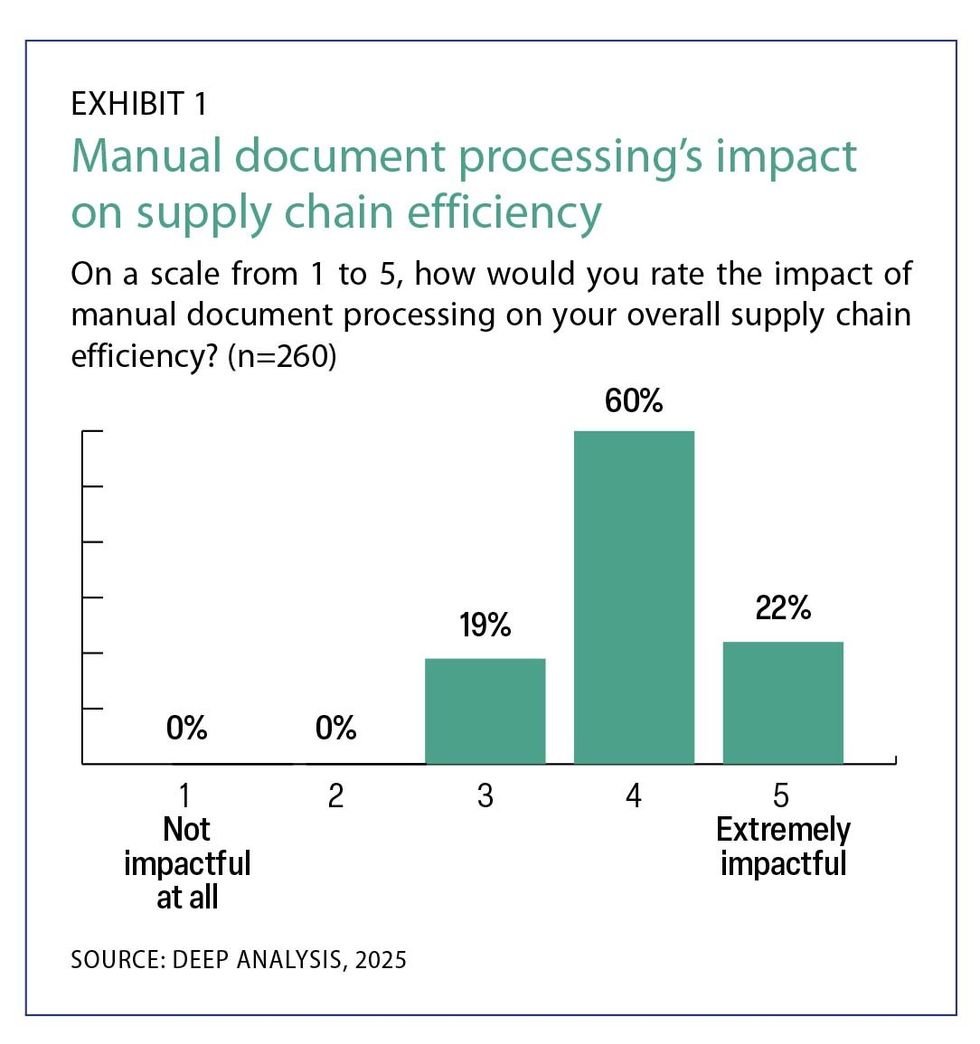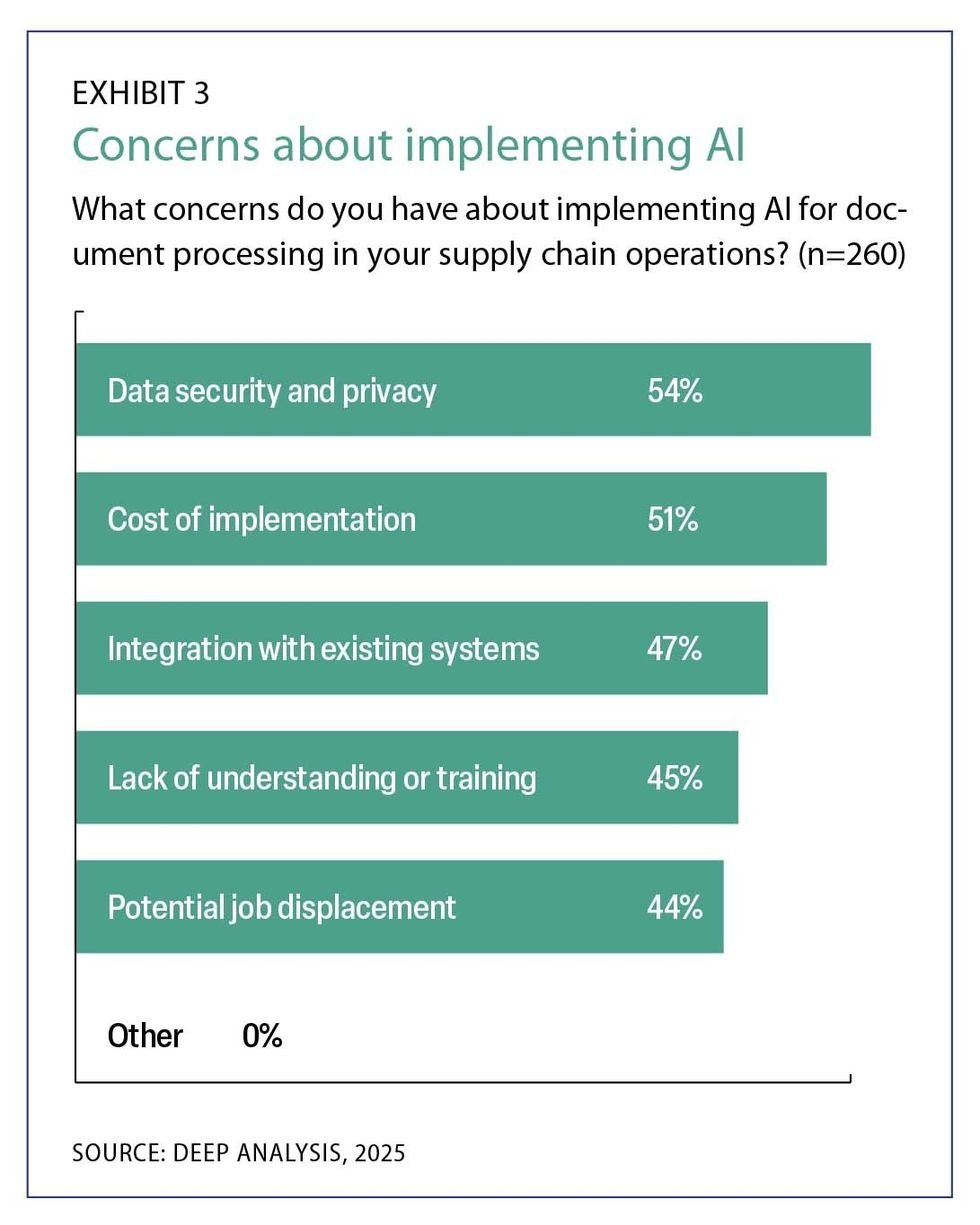AI Insights
KKR Set to Invest in CVC’s Etraveli at €2.7 Billion Valuation

KKR & Co. is buying a significant minority stake in CVC Capital Partners Plc-backed Etraveli Group in a deal valuing the Swedish travel technology firm at about €2.7 billion ($3.1 billion), according to people familiar with the matter.
Source link
AI Insights
Augment AI startup secures $85M for logistics teammate

Given these persistent challenges, could artificial intelligence (AI) be the answer? By automating repetitive tasks—such as invoice validation, exception alerts, and document processing—AI has the potential to streamline workflows, reduce errors, and free up teams to focus on strategic decision-making.
A recent report by research firm Deep Analysis, sponsored by document automation specialist Hyperscience, sheds light on the current state of AI readiness in T&L back-office functions. Titled “Market Momentum Index: AI Readiness in Transportation and Logistics Back-Office Operations,” the report drew on findings from a survey of T&L professionals to reveal both the challenges and opportunities for automation and AI adoption. (For more information about the research and methodology, see sidebar, “About the research.”)
This article summarizes some of the key findings and offers some actionable recommendations for supply chain professionals looking to harness the power of AI to drive efficiency and competitiveness.
THE CRITICAL ROLE OF THE BACK OFFICE
Back-office operations are the administrative core of supply chain processes, encompassing tasks such as order processing, inventory management, billing, compliance documentation, and communications with vendors and carriers. While these tasks are not visible to end consumers, they are vital to maintaining the smooth flow of goods and ensuring on-time deliveries. Furthermore, these operations are typically complex, involving numerous transactions and partners, and, as a result, are often plagued by fragmented processes, duplicated efforts, and misaligned data. Yet, most transportation and logistics companies still depend on manual processes and paper-based systems for their back-office operations, which often lead to errors, delays, and inefficiencies.
For example, the industry relies heavily on documents such as invoices, bills of lading, shipment tracking forms, and compliance records. Many organizations, however, use manual or semi-automated processes to manage these documents. Survey respondents indicated that the manual handling of supply chain documentation is a significant challenge that can have a large impact on overall supply chain efficiency (see Exhibit 1). For instance, missing or incorrect paperwork can cause customs delays, incur fines, or disrupt critical supply chain timelines. Additionally, document handling involves multiple touchpoints, which increases the risk of errors and operational delays. Furthermore, the lack of standardized document formats complicates data sharing and collaboration.
The survey found that many companies have implemented digital tools such as enterprise resource planning (ERP) systems, supply chain management (SCM) systems, transportation management systems (TMS), and warehouse management systems (WMS). These systems were initially marketed as comprehensive solutions capable of automating business processes, improving efficiency, and providing real-time data visibility. However, their effectiveness has been limited by several key challenges. First, high implementation costs and complex integrations often lead to partial deployments, where critical functions remain unautomated. Second, rigid system architectures struggle to adapt to dynamic business needs, forcing employees to rely on manual workarounds—particularly in Excel—to fill functionality gaps. This reliance on spreadsheets introduces high data-entry error rates, inconsistent reporting, and limited data visualization capabilities. Additionally, ineffective user training and resistance to change further hinder adoption, leaving many organizations unable to fully leverage these systems. As a result, despite their potential, ERP, WMS, and similar tools frequently fall short of delivering the promised operational transformation.
THE GROWING INTEREST IN AI
Given the lack of success with other technology tools, there is a perception that supply chain organizations in general—and T&L firms in particular—might be resistant to or uninterested in AI. So it came as a bit of a surprise that the survey results indicated a growing interest in automation and AI within the T&L sector. Over 70% of respondents expressed a willingness to invest in AI-optimized systems, recognizing the potential for these technologies to transform back-office operations.
Of those respondents whose organizations were already using AI, 98% said they view the technology as useful, important, or vital. As Exhibit 2 shows, these respondents are currently employing AI to accomplish a wide range of goals. The report highlights several key areas where AI adds value, such as:
1. Improved decision-making (31%): AI can analyze large volumes of complex data—such as real-time traffic patterns, weather conditions, shipment tracking, and historical trends—to optimize supply chain decisions.
2. Error reduction (28%): For back-office tasks such as data entry, invoice processing, and document management, AI can automate repetitive processes, drastically reducing human error.
3. Enhanced data quality (37%): AI improves data quality by ensuring consistency, standardization, and accuracy, making the data more reliable for decision-making purposes.
Going forward, automation and AI have the potential to reshape the industry, enabling companies to reimagine workflows, prioritize sustainability, and enhance collaboration.

BARRIERS TO AI ADOPTION
Despite the clear potential of AI, significant barriers to adoption remain. The survey respondents reported several concerns about implementing AI for back-office processes (see Exhibit 3). The most common concerns include:
1. Data security and privacy (54%): Transportation and logistics companies handle a large volume of sensitive data, including customer information, shipment details, and payment records. Ensuring robust security protocols and compliance with privacy regulations is critical for any AI implementation.
2. Cost of implementation (51%): AI technologies require considerable upfront investment in both hardware and software, and many smaller logistics firms or those with tight margins may find it difficult to justify this expense.
3. Integration with existing systems (47%): Many logistics companies still rely on traditional TMS and ERP systems that were not built with AI in mind, requiring substantial and extensive investment in infrastructure upgrades.

ESSENTIAL STEPS
No matter how powerful a technology is, its effectiveness in the real world of business is only as good as the planning and execution of a transformation project. As companies look to implement AI, they must make sure to take essential steps such as standardizing data formats, investing in workforce training, and fostering industrywide collaboration. The report concludes with several recommendations for companies looking to adopt AI and automation in their back-office operations, including:
1. Invest in AI training: Providing employees with training on AI tools and systems will help bridge the knowledge gap and increase adoption rates.
2. Focus on incremental implementation: Starting with pilot projects allows companies to assess the technology’s return on investment (ROI) and build confidence in AI technologies before large-scale deployment.
3. Develop industry standards: Collaborate with industry groups to establish standardized document formats and processing protocols, reducing inefficiencies and errors.
4. Prioritize integration: Select AI solutions that integrate seamlessly with existing systems, minimizing disruption during the transition.
5. Monitor emerging technologies: Stay informed about advancements in AI, such as intelligent document processing (IDP) and robotic process automation (RPA), to remain competitive.
THE TIME IS NOW
The transportation and logistics sector is at a pivotal moment, with significant opportunities to leverage AI and automation to address long-standing inefficiencies in back-office operations. While challenges such as integration, cost, and training remain, the industry is moving steadily toward broader adoption of digital and AI-based solutions. By addressing these barriers and focusing on incremental, strategic implementation, companies can unlock the full potential of automation and AI, driving efficiency and competitiveness in an increasingly complex and indeed volatile market.
Some may be understandably skeptical of AI’s ability to truly transform back-office operations, particularly given past failures to digitize paper-based processes. Certainly, no technology is perfect, and its effectiveness is dependent on how well the organization plans and executes its implementation. However, it’s important to note that huge advances have been made in the ability of AI to read, understand, and process document-based processes. As a result, AI has the potential to make relatively light work of anything from invoices to bills of lading, providing accuracy levels typically far higher than were a human to do the work manually.
For supply chain professionals, the message is clear: The future of T&L lies in embracing digital transformation, investing in AI, and fostering collaboration across the industry. The time to act is now.
About the research
In 2024, the document automation company Hyperscience and the Council of Supply Chain Management Professionals (CSCMP) partnered with the research and advisory firm Deep Analysis on a research project exploring the current state of back-office processes in transportation and logistics, and the potential impact of AI. The report, “Market Momentum Index: AI Readiness in Transportation and Logistics Back-Office Operations,” is based on survey results from senior-level managers and executives from 300 enterprises located in the United States. All of these organizations have annual revenues greater than $10 million and more than 1,000 employees. The survey was conducted in November and December of 2024. The full 21-page report can be downloaded for free at https://explore.hyperscience.ai/report-ai-readiness-in-transportation-logistics.
AI Insights
Anthropic to pay authors $1.5 billion in settlement over chatbot training material : NPR

Thriller novelist Andrea Bartz is photographed in her home Thursday in the Brooklyn borough of New York City.
Richard Drew/AP
hide caption
toggle caption
Richard Drew/AP
NEW YORK — Artificial intelligence company Anthropic has agreed to pay $1.5 billion to settle a class-action lawsuit by book authors who say the company took pirated copies of their works to train its chatbot.
The landmark settlement, if approved by a judge as soon as Monday, could mark a turning point in legal battles between AI companies and the writers, visual artists and other creative professionals who accuse them of copyright infringement.
The company has agreed to pay authors about $3,000 for each of an estimated 500,000 books covered by the settlement.
“As best as we can tell, it’s the largest copyright recovery ever,” said Justin Nelson, a lawyer for the authors. “It is the first of its kind in the AI era.”
A trio of authors — thriller novelist Andrea Bartz and nonfiction writers Charles Graeber and Kirk Wallace Johnson — sued last year and now represent a broader group of writers and publishers whose books Anthropic downloaded to train its chatbot Claude.
The Anthropic website and mobile phone app are shown in this photo in New York on July 5, 2024.
Richard Drew/AP
hide caption
toggle caption
Richard Drew/AP
A federal judge dealt the case a mixed ruling in June, finding that training AI chatbots on copyrighted books wasn’t illegal but that Anthropic wrongfully acquired millions of books through pirate websites.
If Anthropic had not settled, experts say losing the case after a scheduled December trial could have cost the San Francisco-based company even more money.
“We were looking at a strong possibility of multiple billions of dollars, enough to potentially cripple or even put Anthropic out of business,” said William Long, a legal analyst for Wolters Kluwer.
U.S. District Judge William Alsup of San Francisco has scheduled a Monday hearing to review the settlement terms.
Anthropic said in a statement Friday that the settlement, if approved, “will resolve the plaintiffs’ remaining legacy claims.”
“We remain committed to developing safe AI systems that help people and organizations extend their capabilities, advance scientific discovery, and solve complex problems,” said Aparna Sridhar, the company’s deputy general counsel.
As part of the settlement, the company has also agreed to destroy the original book files it downloaded.
Books are known to be important sources of data — in essence, billions of words carefully strung together — that are needed to build the AI large language models behind chatbots like Anthropic’s Claude and its chief rival, OpenAI’s ChatGPT.
Alsup’s June ruling found that Anthropic had downloaded more than 7 million digitized books that it “knew had been pirated.” It started with nearly 200,000 from an online library called Books3, assembled by AI researchers outside of OpenAI to match the vast collections on which ChatGPT was trained.
Debut thriller novel The Lost Night by Bartz, a lead plaintiff in the case, was among those found in the Books3 dataset.
Anthropic later took at least 5 million copies from the pirate website Library Genesis, or LibGen, and at least 2 million copies from the Pirate Library Mirror, Alsup wrote.
The Authors Guild told its thousands of members last month that it expected “damages will be minimally $750 per work and could be much higher” if Anthropic was found at trial to have willfully infringed their copyrights. The settlement’s higher award — approximately $3,000 per work — likely reflects a smaller pool of affected books, after taking out duplicates and those without copyright.
On Friday, Mary Rasenberger, CEO of the Authors Guild, called the settlement “an excellent result for authors, publishers, and rightsholders generally, sending a strong message to the AI industry that there are serious consequences when they pirate authors’ works to train their AI, robbing those least able to afford it.”
The Danish Rights Alliance, which successfully fought to take down one of those shadow libraries, said Friday that the settlement would be of little help to European writers and publishers whose works aren’t registered with the U.S. Copyright Office.
“On the one hand, it’s comforting to see that compiling AI training datasets by downloading millions of books from known illegal file-sharing sites comes at a price,” said Thomas Heldrup, the group’s head of content protection and enforcement.
On the other hand, Heldrup said it fits a tech industry playbook to grow a business first and later pay a relatively small fine, compared to the size of the business, for breaking the rules.
“It is my understanding that these companies see a settlement like the Anthropic one as a price of conducting business in a fiercely competitive space,” Heldrup said.
The privately held Anthropic, founded by ex-OpenAI leaders in 2021, said Tuesday that it had raised another $13 billion in investments, putting its value at $183 billion.
Anthropic also said it expects to make $5 billion in sales this year, but, like OpenAI and many other AI startups, it has never reported making a profit, relying instead on investors to back the high costs of developing AI technology for the expectation of future payoffs.
AI Insights
PR News | Will Artificial Intelligence Destroy the Communications Industry?

| Simon Erskine Locke |
I recently met a leader in the communications industry, and as we were chatting over coffee, he shared that he’s been hearing the phrase “two things can be true at the same time” a lot recently. This is also something I’ve been saying for a couple of years in discussions around politics, AI, and a variety of other issues.
In a polarized world in which opinions are shared as fact, data and statistics are made to fit ideologies and the truth doesn’t seem to matter, expressing the view that two seemingly contradictory perspectives can both be true is a pragmatic way to find common ground. It recognizes that there are different ways to look at the same issues.
While making the effort to recognize different perspectives is healthy, idealogues (on either side of the political spectrum) are rarely interested in recognizing that there may be another side to an argument. When you are devoted to a particular position, the idea of an alternate version — or even the acknowledgement that there may be grey between black and white — creates cognitive dissonance.
Why bring this up? In part, because many of the discussions around AI seem to be somewhat bipolar.
For many, AI is still the shiny new tool that will write great emails, automate the lengthy process of engaging with journalists, or lead to faster and easier content generation. For others, AI will kill jobs, dumb down the industry, or lead us to an existential doomsday in which the rise of content leads to the fall of engagement.
As someone who has spent significant time with AI companies, building tools, working with various LLMs, and discussing the impact of AI with lawmakers, I firmly believe that there are reasons to be optimistic and pessimistic. It’s not all black and white.
One way to frame the discussion of AI is to think of it like electricity. Electricity is key to powering the economy and it drives machines that do a lot of different things. Some of those are good. Some are not. Electricity gives us light, but it can also kill us.
AI, like electricity, is not intrinsically good or bad. It’s what we do with it that matters. As communicators, we have agency. We decide which choices will shape the future of the industry. We are not powerless.
We are responsible for making decisions about how AI is employed. And, consequently, if we get this wrong, shame on us. If communicators ultimately put the industry out of business by automating the engagement process with journalists, mass producing content to game LLM algorithms, and delegating thinking to chatbots — rather than helping the next generation of communicators hone their writing, editing, fact checking, and critical thinking skills — that will be on us.
Equally, if we don’t leverage AI, we will miss an opportunity. AI can help streamline workflows and its access to the vast body of knowledge on the internet can lead to smarter, more informed engagement with reporters and impactful content.
A key takeaway from conversations with AI startups is that they are now able to do things that were simply not possible two years ago. One is making the restaurant booking process more efficient, leading to greater longevity of the businesses they work with – which keeps staff employed. Another company’s voice technology is enabling local government to serve constituents at any time and in any language.
As with every other generational technology shift, some jobs will disappear, and others will be created. Communicators need to avoid both being Panglossian, and the trap of seeing AI as the end of days.
Finding the right use cases and effectively implementing the technology will be essential. The customer service line of a major financial institution states, “We are using AI to deliver exceptional customer service”, only to require the customer to repeat the same basic information three times. This underscores the distance between AI’s potential and the imperfect experience most of us see every day.
Pragmatic agency and corporate communications leaders will continue to experiment, invest time to understand what is now possible with AI. They will need to implement tools selectively, while carefully considering the impact of decisions on the industry in the years to come.
At this stage, there is an element of the blind leading the blind with AI. Startups are not omniscient. Communicators looking at applications as a magic bullet are going to be sorely disappointed. We are already seeing questions about the returns on the rush of gold into AI, significant gaps between the vision and experience, and the dark side of the technology in areas such as rising fraud and malicious deepfakes. As I have written previously AI is creating new problems to solve – and is a driving force behind new solutions including content provenance authentication.
Just because you can do something doesn’t mean you should — without careful consideration of use cases, consequences and implementation. AI has both enormous potential but also brings a whole new set of challenges and, potentially, existential risks. The idea that these two seemingly opposite things can be true underscores the weight of responsibility we have to get this right.
***
Simon Erskine Locke is founder & CEO of CommunicationsMatch™ and cofounder & CEO of Tauth.io, which provides trusted content authentication based on C2PA standards. He is a former head of communications functions at Prudential Financial, Morgan Stanley and Deutsche Bank, and founder of communications consultancies.
-

 Business1 week ago
Business1 week agoThe Guardian view on Trump and the Fed: independence is no substitute for accountability | Editorial
-
Tools & Platforms4 weeks ago
Building Trust in Military AI Starts with Opening the Black Box – War on the Rocks
-

 Ethics & Policy1 month ago
Ethics & Policy1 month agoSDAIA Supports Saudi Arabia’s Leadership in Shaping Global AI Ethics, Policy, and Research – وكالة الأنباء السعودية
-

 Events & Conferences4 months ago
Events & Conferences4 months agoJourney to 1000 models: Scaling Instagram’s recommendation system
-

 Jobs & Careers2 months ago
Jobs & Careers2 months agoMumbai-based Perplexity Alternative Has 60k+ Users Without Funding
-

 Education2 months ago
Education2 months agoVEX Robotics launches AI-powered classroom robotics system
-

 Funding & Business2 months ago
Funding & Business2 months agoKayak and Expedia race to build AI travel agents that turn social posts into itineraries
-

 Podcasts & Talks2 months ago
Podcasts & Talks2 months agoHappy 4th of July! 🎆 Made with Veo 3 in Gemini
-

 Podcasts & Talks2 months ago
Podcasts & Talks2 months agoOpenAI 🤝 @teamganassi
-

 Education2 months ago
Education2 months agoMacron says UK and France have duty to tackle illegal migration ‘with humanity, solidarity and firmness’ – UK politics live | Politics

